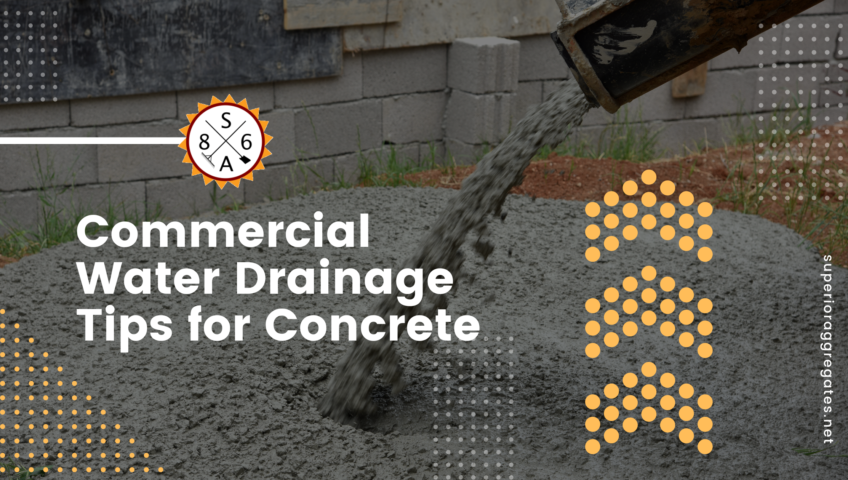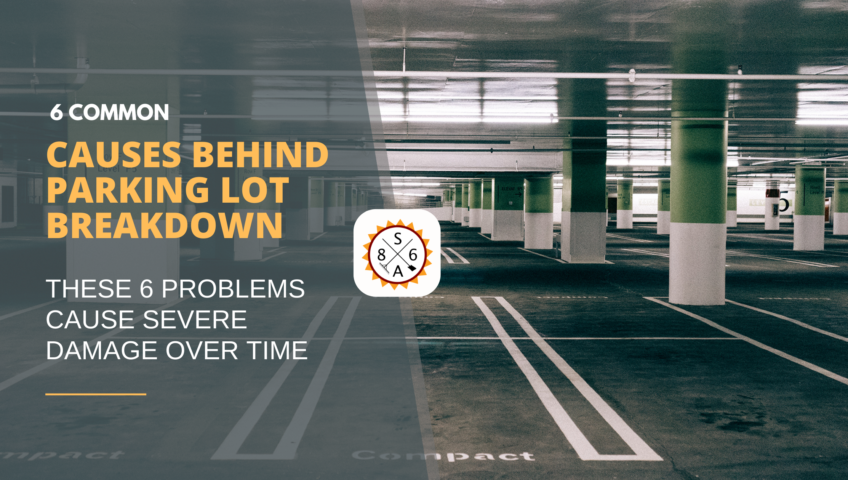
Commercial Water Drainage Tips for Concrete
If you have a concrete outdoor area such as a parking lot or patio that is having issues with drainage, there are things that can be done to help. Start by implementing these three improvements:
1. A Porous Top Paving Layer – Adding a coating such as asphalt will help the area to absorb some water. While asphalt will not absorb all of the water from a large rain storm, it will typically absorb between five to ten percent of the water, helping to eliminate deep puddles. Asphalt drainage is typically not thought of when other drainage solutions are being considered, but it can be an extremely cost effective way to improve the appearance and reduce the maintenance on a property.
2. Surface and Subsurface Drainage – Have a professional asphalt paving company review your surface and subsurface drainage systems. Often, regular maintenance will help to eliminate blockages such as debris and weeds clogging inlets. In some cases it may be a good idea to construct a new drain inlet or even add additional water storage under the concrete.
3. Local Conditions – People often wonder why their concrete pad has suddenly stopped draining water after a storm, especially if it has “worked” for years”. If nothing is wrong with the coating and drain maintenance is up to date, it might just be that local conditions have changed. This may mean that there are more storms, or improvements in the nearby area may be forcing water onto your property. Fortunately, asphalt companies are often able to devise a solution to help. Here are four of the most common solutions that are implemented by our team of professionals.
4 Ways Concrete and Asphalt Can Aid Commercial Drainage
1. Pervious Concrete – Pervious concrete has been around for a few decades, but the recent change in weather patterns and a focus on eliminating standing water has caused a renewed surge in interest. Pervious concrete can be poured into just about any shape or pattern you can imagine, and it will topically absorb three to four times more water than “standard” concrete.
2. Concrete Drainage Additions Can Assist Standard Blends – If you’re looking at improving the drainage in an already existing concrete structure, then you’ll likely want to construct additional drains. This may mean adding more inlets, and/or improving the drainage system so that more water can be stored by adding additional piping or gravel drainage under or around the area.
3. Concrete and Asphalt Can Be Sloped – Adding a slight slope to a concrete or asphalt area will help water to drain to an empty field. These slopes are very mild (typically less than 2%), and most people don’t notice that a parking lot or patio is sloped when they’re using it. In fact, most paved areas are designed to have a slight slope, but over time it’s possible for asphalt, concrete, and the gravel underneath them to shift slightly, essentially “flattening out” these areas.
4. Asphalt Can Also Be Extra-Porous. Apshalt, like concrete, can be mixed and poured to be more or less porous. Consider using a type of asphalt that is more porous. This will allow an area to absorb more water, increasing the overall absorption in some cases by up to ten percent or more.
If you have a concrete outdoor area such as a parking lot or patio that is having issues with drainage, there are things that can be done to help. Start by implementing these three improvements:
1. A Porous Top Paving Layer – Adding a coating such as asphalt will help the area to absorb some water. While asphalt will not absorb all of the water from a large rain storm, it will typically absorb between five to ten percent of the water, helping to eliminate deep puddles. Asphalt drainage is typically not thought of when other drainage solutions are being considered, but it can be an extremely cost effective way to improve the appearance and reduce the maintenance on a property.
2. Surface and Subsurface Drainage – Have a professional asphalt paving company review your surface and subsurface drainage systems. Often, regular maintenance will help to eliminate blockages such as debris and weeds clogging inlets. In some cases it may be a good idea to construct a new drain inlet or even add additional water storage under the concrete.
3. Local Conditions – People often wonder why their concrete pad has suddenly stopped draining water after a storm, especially if it has “worked” for years”. If nothing is wrong with the coating and drain maintenance is up to date, it might just be that local conditions have changed. This may mean that there are more storms, or improvements in the nearby area may be forcing water onto your property. Fortunately, asphalt companies are often able to devise a solution to help. Here are four of the most common solutions that are implemented by our team of professionals.
4 Ways Concrete and Asphalt Can Aid Commercial Drainage
1. Pervious Concrete – Pervious concrete has been around for a few decades, but the recent change in weather patterns and a focus on eliminating standing water has caused a renewed surge in interest. Pervious concrete can be poured into just about any shape or pattern you can imagine, and it will topically absorb three to four times more water than “standard” concrete.
2. Concrete Drainage Additions Can Assist Standard Blends – If you’re looking at improving the drainage in an already existing concrete structure, then you’ll likely want to construct additional drains. This may mean adding more inlets, and/or improving the drainage system so that more water can be stored by adding additional piping or gravel drainage under or around the area.
3. Concrete and Asphalt Can Be Sloped – Adding a slight slope to a concrete or asphalt area will help water to drain to an empty field. These slopes are very mild (typically less than 2%), and most people don’t notice that a parking lot or patio is sloped when they’re using it. In fact, most paved areas are designed to have a slight slope, but over time it’s possible for asphalt, concrete, and the gravel underneath them to shift slightly, essentially “flattening out” these areas.
4. Asphalt Can Also Be Extra-Porous. Apshalt, like concrete, can be mixed and poured to be more or less porous. Consider using a type of asphalt that is more porous. This will allow an area to absorb more water, increasing the overall absorption in some cases by up to ten percent or more.

